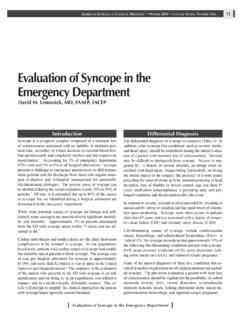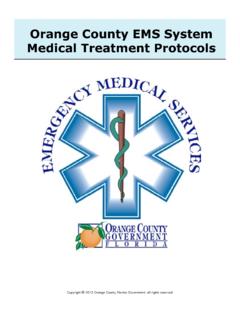Transcription of EMERGENCY ULTRASOUND CODING AND REIMBURSEMENT
1 EMERGENCY ULTRASOUND CODING AND REIMBURSEMENT ULTRASOUND Section American College of EMERGENCY Physicians Contributors Stephen Hoffenberg, MD, FACEP Vivek S. Tayal, MD, FACEP Anthony J. Dean, MD Gary Quick, MD, FACEP Evelyn E. Cardenas, MD, FACEP Marilyn Bromley, RN 2 Table of Contents I Introduction II Background III CPT CODING of ULTRASOUND Procedures A. Current Procedural Terminology (CPT) B. Limited vs Complete ULTRASOUND Studies C. CPT Modifiers D. CPT Codes for ULTRASOUND Procedures IV ICD-9 CODING and Medical Necessity A.
2 ICD-9 CODING B. Medical Necessity V ULTRASOUND Procedure Documentation A. Documentation Background B. Documentation and Image Archiving C. Documentation Requirements VI Payor Policy A. Payor Policy Background B. Covered Services and Non-Covered Services C. CODING Edits VII Frequently Asked Questions (FAQs) Acknowledgments: The authors wish to thank the following persons for assistance in preparation of this material: Dennis M. Beck, MD, FACEP; Peter L. Sawchuk, MD, JD, MBA; Mason A. Smith, MD, FACEP; and David McKenzie, Staff Liaison, REIMBURSEMENT and CODING and Nomenclature Advisory Committees.
3 3 I Introduction As ULTRASOUND technology has been incorporated into the practice of EMERGENCY medicine, emphasis has appropriately been placed upon ULTRASOUND program development, research and education. Practicing EMERGENCY physicians, in both community and academic settings, have become credentialed to perform ULTRASOUND examinations and have integrated essential ULTRASOUND studies into their clinical practice. Little guidance, however, has been provided to the EMERGENCY physician in understanding the key elements of the CODING or REIMBURSEMENT for ULTRASOUND procedures.
4 The goal of this paper is to assist EMERGENCY physicians in understanding correct and compliant CODING , appropriate documentation, payor policy and issues surrounding claims submission for EMERGENCY physician ULTRASOUND examinations they are currently performing or may anticipate performing. This paper addresses the following CODING and REIMBURSEMENT issues: Identification of the ULTRASOUND procedures performed in your department by the CPT codes and CPT code modifiers that accurately describe those ULTRASOUND procedures Identification of the medical indications for the use of each ULTRASOUND procedure performed, represented by ICD-9 codes, that accurately reflect the symptoms, signs, diagnosis and/or abnormal diagnostic tests that necessitate ULTRASOUND procedures Developing medical record documentation methods that accurately identify procedures performed, and appropriate procedure results reporting.
5 These documentation elements serves as the basis for applying the correct CPT and ICD-9 codes for the individual patient Developing a compliant approach to claims submission that recognizes payor policies including covered services, CODING edits, CODING combinations and evaluation of claims denials. Note: The American College of EMERGENCY Physicians makes every effort to ensure that contributors to College-sponsored publications are knowledgeable authorities in their fields. Readers are nevertheless advised that the statements and opinions expressed in this series are provided as guidelines and should not be construed as College policy unless specifically cited as such.
6 The College disclaims any liability or responsibility for the consequences of any actions taken in reliance on those statements or opinions. The materials contained herein are not intended to establish policy, procedure, or a standard of care. Finally, this paper addresses CODING and REIMBURSEMENT policy and regulation that are subject to change, vary by region and vary by payor. The reader is advised to confirm that the material addressed here is current for their specific location. II Background ULTRASOUND is a well-established medical imaging modality utilized by a wide variety of medical specialties.
7 The medical literature continues to demonstrate a growing recognition of ULTRASOUND s clinical utility for both diagnostic imaging and the guidance of difficult or high-risk procedures. Education in the use of ULTRASOUND has been integrated into the residency training of a variety of medical specialties, including EMERGENCY medicine. Technologic improvements in ULTRASOUND equipment have made systems more portable, easier to use at the bedside and of higher image quality, thus, enhancing the accuracy of diagnosis and the safety of procedure performance. The performance of ULTRASOUND examinations and the interpretation of ULTRASOUND images is within the scope of practice of the EMERGENCY medicine specialist as outlined in the Use of ULTRASOUND Imaging by EMERGENCY Physicians (ACEP policy number 400121).
8 The policy promotes the immediate availability of ULTRASOUND examination and interpretation on a 24-hour-a-day basis for ED patients and identifies EMERGENCY ULTRASOUND performance as a standard EMERGENCY physician skill that should be 4 delineated in the EMERGENCY physician s clinical privileges. In addition, the policy supports dedicated ULTRASOUND equipment within the EMERGENCY department as being optimal for patient care. Bedside ultrasonography is included among the Procedures and Skills Integral to the Practice of EMERGENCY Medicine in the Model of the Clinical Practice of EMERGENCY Medicine (ACEP policy number 400297; Annals of EMERGENCY Medicine June 2001).
9 Finally, an authoritative overview of the status of EMERGENCY ultrasonography can be found in the recently released ACEP EMERGENCY ULTRASOUND Guidelines-2001, and is available on the ACEP website ( ). These ACEP EMERGENCY ULTRASOUND Guidelines 2001 address the scope of practice, the primary indications for ULTRASOUND in the EMERGENCY setting, procedural guidance indications for ULTRASOUND , training, credentialing, quality improvement and future potential uses for EMERGENCY ULTRASOUND . It is clear that EMERGENCY physicians who perform EMERGENCY ULTRASOUND should be both credentialed to perform those examinations and that EMERGENCY physicians should be appropriately reimbursed for providing EMERGENCY ULTRASOUND procedures in the EMERGENCY department .
10 (ACEP policy Use of ULTRASOUND Imaging by EMERGENCY Physicians #400121) Agreement with these basic concepts is reflected in existing AMA Policy supporting REIMBURSEMENT for ULTRASOUND imaging performed by appropriately trained physicians ( REIMBURSEMENT for Office-Based or Outpatient ULTRASOUND Imaging) and in AMA policy affirming that the granting of privileges to perform ULTRASOUND imaging in a hospital setting is a function of the hospital medical staff and that such criteria should be based on specialty-specific training standards ( Privileging for ULTRASOUND Imaging). For a more in depth understanding of EMERGENCY ULTRASOUND procedures and the CODING of these procedures the reader is referred to the following publications: ACEP EMERGENCY ULTRASOUND Guidelines 2001 ( ) Use of ULTRASOUND Imaging by EMERGENCY Physicians (Policy number 400121; ) Current Procedural Terminology CPT 2001 (AMA Press; ) Physician ICD-9-CM (Medicode; ) Principles of CPT CODING (AMA Press; ) Healthcare Fraud and Abuse: A Physicians Guide to Compliance (AMA Press; ) Medicare Correct CODING and Payment Manual for Procedures and Services (St.)






